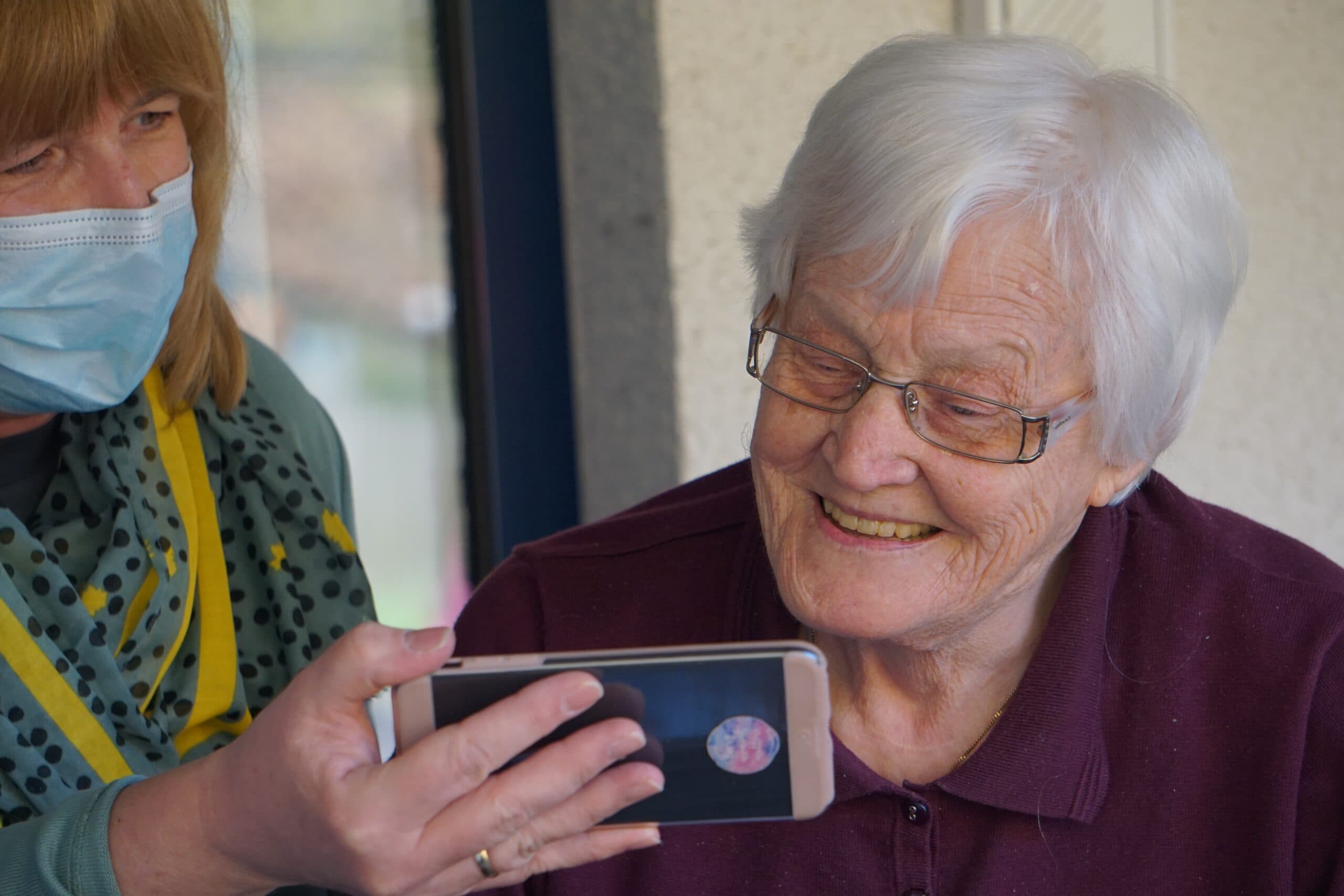Creating effective assisted living website design is a mix of design, technology, and a whole lot of empathy.
Assisted living and senior living websites aren’t just supposed to look pretty (and they are), but they should also be informative and helpful. Their goal is to connect your reader and their loved ones to the perfect community.
Your website is the digital front door and cozy living room where your visitors will decide if they’ll stay and continue reading, or leave right away.
In this article, I’ll guide you through the best web designs and elements to include in your senior living website to optimize lead generation and increase your senior community’s occupancy.
Why your assisted living website design matters
When your online audience is researching assisted living homes for their loved ones, they’re not making the decision lightly.
Your assisted living or senior living community’s website serves as the first impression, a bridge, between anxious families and their new potential home for their loved ones.
This website bridge is more than just pixels and text on a screen. It must carry the weight of emotion, trust, and hope as well.
1. Emotional connection from assisted living website design
Families are searching for a forever home for their loved ones—a place where they can age in place in a loving, home-like atmosphere.
Having a well-designed website can paint this picture for your readers, allowing them to imagine their loved ones sitting in sunlight rooms, enjoying activities, and being treated with dignity.
2. Building trust with a senior living website
Trust in the senior living community is the most important because people are naturally skeptical of assisted living communities. Nobody wants to send their mother to a poorly rated community.
Showcasing transparent information, like genuine testimonials or real photographs from the community (with real residents, not stock images) creates the narrative of reliability and trust. It’s about showing the readers, “Your loved ones are safe and valued here.”
3. Showcasing amenities of your senior living community
A lot of readers on assisted living websites are looking for pictures, videos, or tours first because this visual information can tell them more than words alone.
Highlight your community’s spaces where residents engage in hobbies, the gardens where they relax, or the dining areas where they enjoy fine dining.
4. Improved web accessibility for all
It’s important for your website to be pretty, but it must also function on a practical level.
This means using readable fonts, having intuitive navigation, and displaying clear call-to-action buttons so that every user, regardless of their age or tech-savviness, can find what they need without frustration.
5. The role of lead generation in assisted living website design
Although there are no exact figures, studies have shown a large percentage of potential residents or their caregivers will visit your community’s website first before contacting you.
And yes, referrals are still a very important part of the lead generation process, but what happens after a person hears about your assisted living community? They’ll Google you, of course.
Think of your website then as the digital seal of approval, a reinforcement of the word-of-mouth praise they’ve heard before from friends and family.
6 must-have features for effective assisted living website design
Your website is the digital face of your assisted living and senior living community. The site must be equipped with features that offer an easy, informative, convincing, and comforting experience to your visitors.
Let’s look at the essential features of a successful assisted living website.
1. Mobile-responsive design
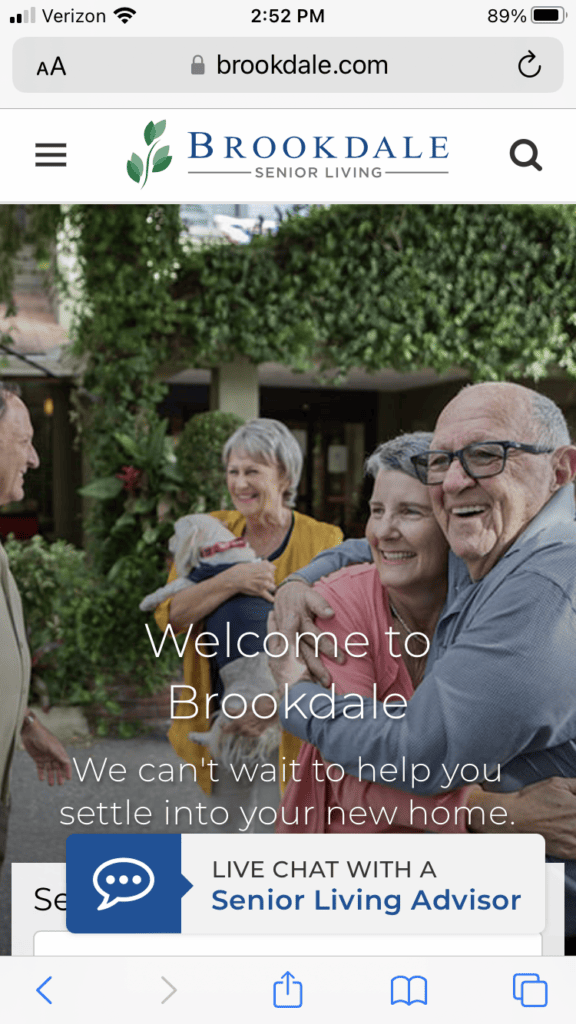
The mobile phone is no longer just a millennial’s toy—they’re used by everybody, from the tech-savvy grandson to a 60-year-old caregiver looking for options for her ailing mother.
Having a mobile-responsive design means your website will display properly on any device or varying sizes, such as an iPhone, Android phone, or tablet.
Remember, half of your website’s traffic is being viewed from a mobile phone, and that Google prioritizes mobile-friendly websites in its search results.
So do a test: Open up your senior living website on your phone and note what kind of experience you have navigating your own website.
2. Intuitive navigation
Your website’s readers, who will primarily be the caregivers, are on a mission.
Their mission is to collect information, assess your facilities, and contact your community directly.
Having intuitive navigation ensures they’ll stay on your website long enough to find all the information they need and contact you from your website.
Whether it’s a 3D tour, pricing details, or visiting hours, all this information should be a click away (or three clicks away, according to one website design rule).
3. Virtual tours and galleries
These are perhaps some of the most important design elements you could add to your website.
Sure, having an active blog page is necessary for drawing in new traffic to your website, but it’s really the images and tours that will speak directly to your reader’s hearts.
This is why every senior living community needs to have high-quality images for a sneak peek into the community. Take, for example, the beautiful community of The Kensington Reston pictured above. Their virtual tour allows users to explore their luxurious accommodations before they even visit.
Take the time to invest in a photographer who can take well-lit, high-resolution photographs that are professional, inspiring, and not amateurish or low quality (because this will scare your visitors away!)
4. Testimonials and reviews
Word of mouth in the digital age means having testimonials and reviews on your website. These snippets of real experiences, straight from the residents or their families, serve as powerful trust signals and social proof.
They humanize the community, share real stories from real residents, and offer insights that a glossy brochure might miss.
5. Interactive floor plans
Your website needs to be able to let the reader visualize their loved one living there. This means adding floor plans, hopefully interactive floor plans or 3D tours that your visitors can browse to visualize the space.
It’s a step towards making your unfamiliar senior living residence familiar to the readers.
6. Clear calls to action (CTAs)
You have attracted visitors to your senior living website to achieve a goal—generating a new lead to increase your occupancy, right?
To do so, you need to have very clear and compelling CTAs that guide your reader to take the next step, which is usually to “schedule a tour,” “contact us for information on floor plans,” or “contact us for help.”
Without clear CTAs, your readers simply will not reach out to you and they will leave your website without taking any clear action.
6 features to avoid in assisted living website design
A well-designed website for assisted living and senior living communities can offer hope to your readers.
A poorly designed website can scare away your visitors and turn them off from the idea of assisted living entirely.
Let’s look at the web design mistakes to avoid.
1. Overwhelming amount of text
Avoid adding too much information, like a huge wall of text without line breaks or paragraphs, because your readers will not be able to quickly find the information they’re looking for.
Instead, they’ll “bounce” off your website, which means they’ll leave without reading or clicking anything because you’ve overwhelmed them.
Having whitespace on a website isn’t “empty” space—it’s breathing room for the eyes, making your content easily digestible and your navigation more comfortable.
2. Complicated menus and submenus
Readers should find the information they need under three clicks, and even then, three clicks can be too many in certain instances.
This means offering a simple, intuitive, and easy navigation process so that any person can find the information they need instantly.
If you’re unsure if your navigation is too complex, consider user-testing your website by having somebody unfamiliar with your website achieve certain tasks, such as finding the company’s phone number or amenities page.
3. Outdated visuals
Your visuals are a reflection of your community—having outdated photos on your website likely means your community is outdated, too. This can signal to your readers that your facility might be behind the times.
Think about the impression you want potential clients to have of your community—create visuals that achieve that impression.
4. Auto-play videos and loud background music
Many older users, and younger users too, find unsolicited noise distressing, and auto-playing videos or messages can detract from your website’s primary message.
They’re also a great way to get people to leave your website instantly, so avoid any autoplaying distractions from your website.
5. Pop-up advertisements or surveys
Nobody likes pop-up ads. Nobody.
While they are sometimes helpful, they usually disrupt the user’s experience, especially if they appear too soon or are challenging to close. “How do I X out of this?”
Also, pop-up ads and surveys can slow your page loading times, increasing your reader’s frustration levels.
6. Non-descriptive links
Having links that just say “Click here” or “Learn more” do not get clicked because they’re vague, confusing, and borderline suspicious.
Instead, rename your hyperlinks with a clear indication of where they’ll lead your readers, such as “View Our Amenities,” “View Floor Plans,” or “Take a 3D Tour.”
9 best examples of successful assisted living website designs
Website design is subjective. What might appeal to one caregiver or senior might not resonate with another.
However, by showcasing some standout designs in the assisted living and senior living sector, you can begin exploring high-quality and high-ranking websites to get a feel for what design elements particularly stand out to you and how they make you feel.
Read more: How to Select the Right Senior Living Marketing Agency.
1. Brookdale Senior Living
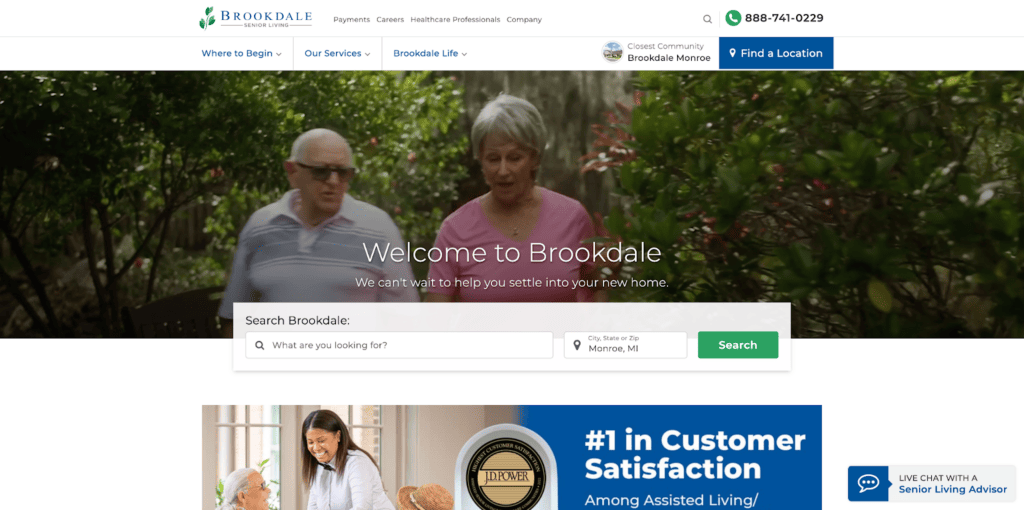
Brookdale Senior Living’s website’s clean and sophisticated design makes navigation seamless.
- Ample whitespace enhancing readability.
- Trust signals highlighting accolades: “Most Communities Recognized by US News and World Report for two years.”
- Use a user-friendly search bar to find the nearest Brookdale community.
- Contains an auto-playing video (silent) with no impact on loading speed.
2. Sunrise Senior Living
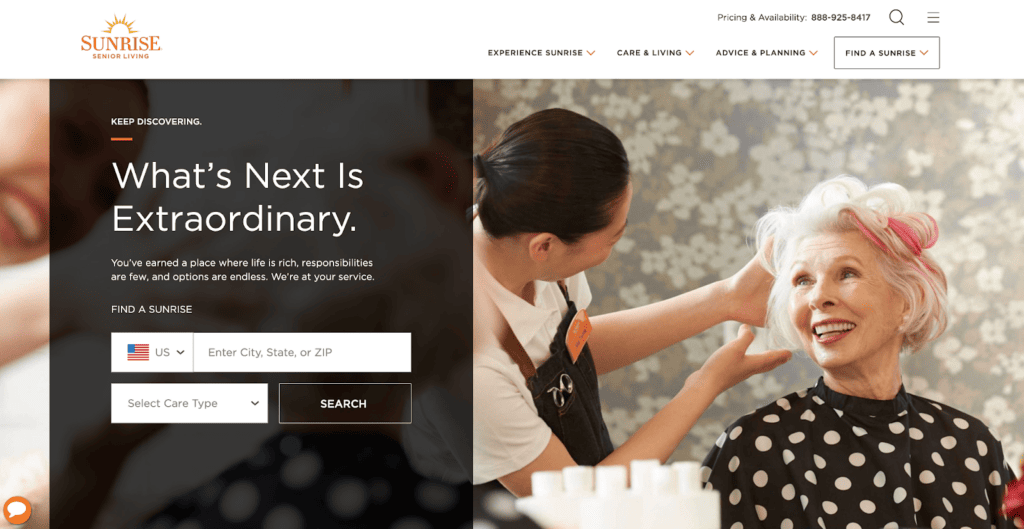
Sunrise Senior Living’s website prioritizes functionality with intuitive search and navigation options.
- Efficient search bar for assisted living, independent living, and memory care.
- Separate tab for potential employee job applications.
- Streamlined and intuitive navigation.
3. Atria Senior Living
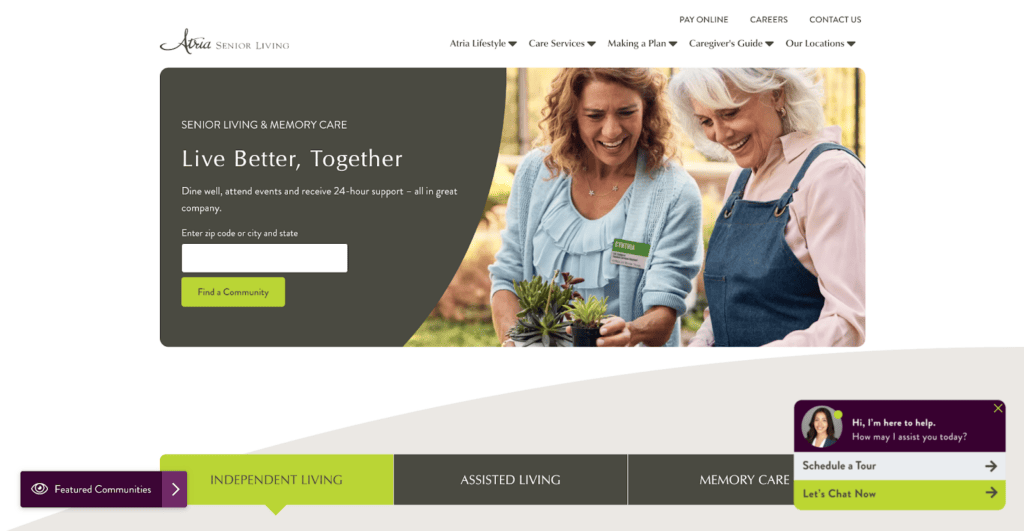
Atria Senior Living’s website is designed for quick access to essential information.
- Top search bar with zip code feature for community location.
- Clearly laid-out navigation for key areas.
- Options to browse independent living assisted living, and memory care facilities.
4. Five Star Senior Living
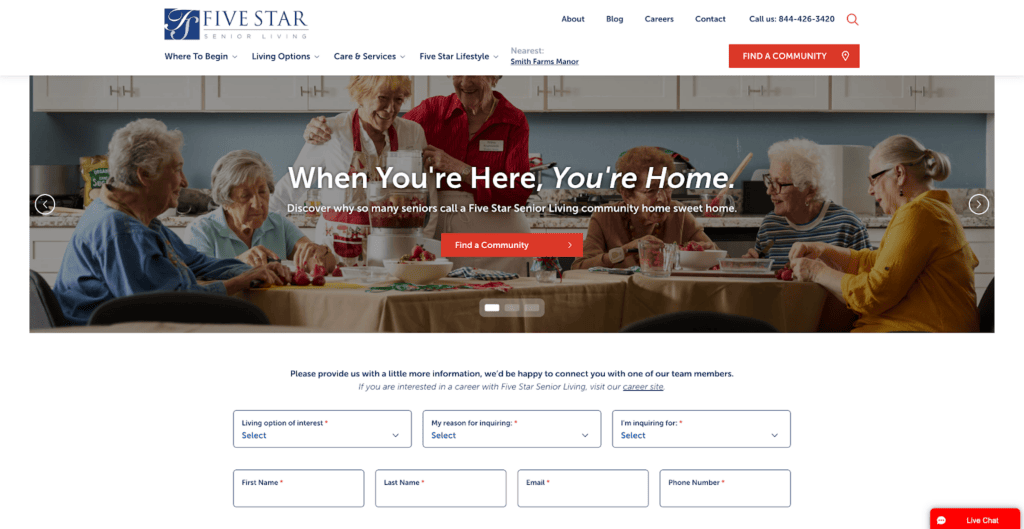
Five Star Senior Living’s website is optimized for lead generation and user engagement.
- Distinct navigation menu.
- Prominently placed lead query form above the fold.
- Dedicated link for healthcare worker applications.
- The prominent “Find a community” button ensures user engagement.
5. Senior Lifestyle
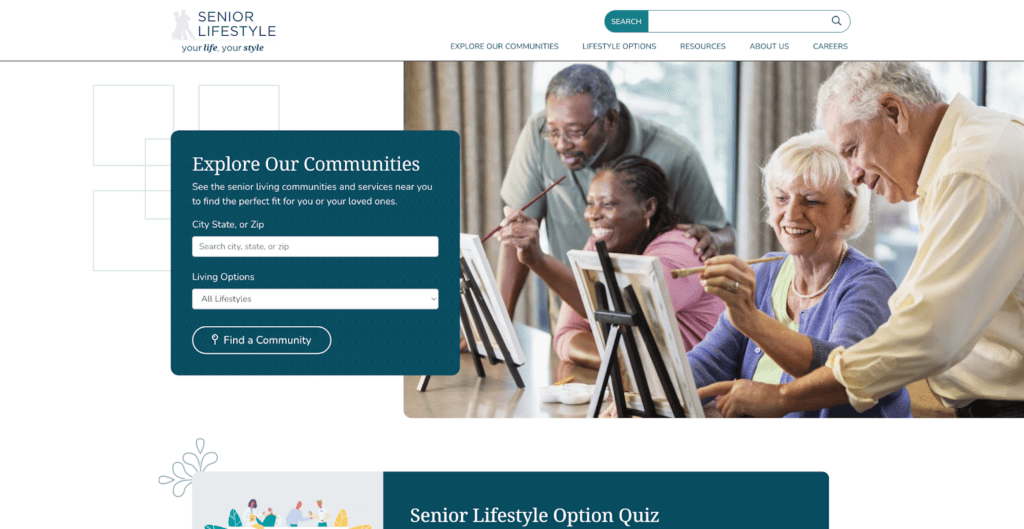
Senior Lifestyle’s website incorporates interactive elements for user engagement and lead generation.
- Streamlined navigation with easy-to-find categories.
- “Senior lifestyle option quiz” further down for user interaction.
- Search bar featuring assisted living, independent living, or memory care selection.
6. Capital Senior Living
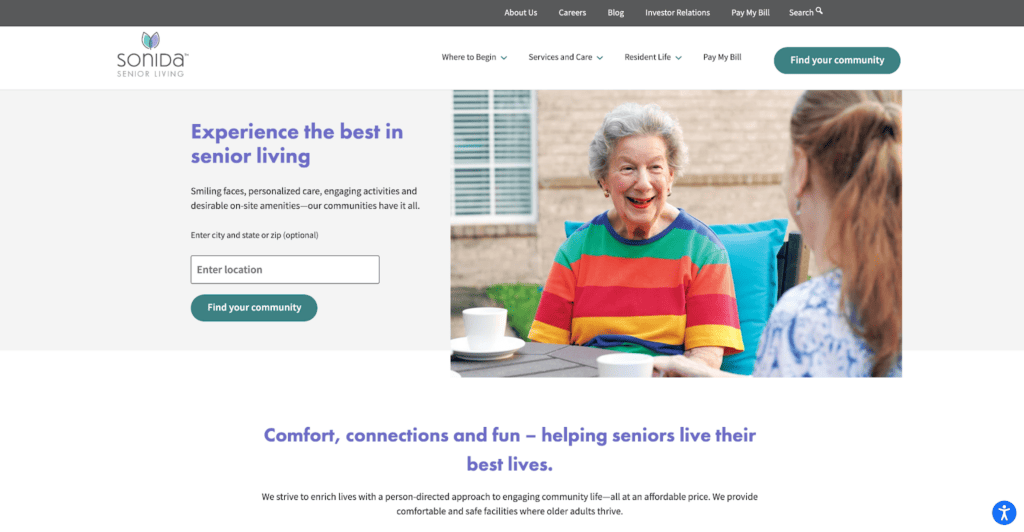
Capital Senior Living’s website balances aesthetics with functionality.
- “Find your community” is prominently displayed for ease of access.
- Direct link for bill payments – a unique feature.
- Bold mission statement capturing company values and purpose.
7. Meridian Senior Living
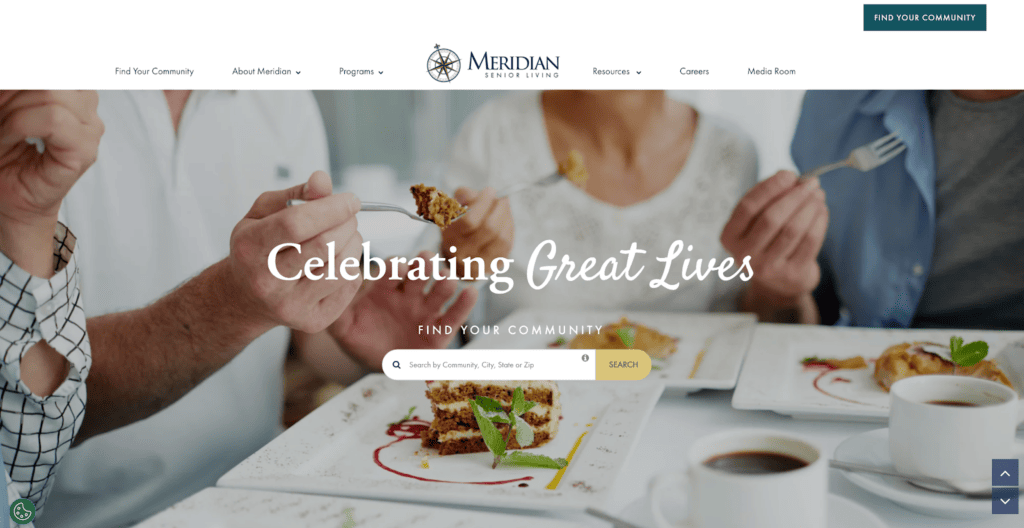
Meridian Senior Living’s website has a professional design emphasizing simplicity and ease of use.
- Clean aesthetics and navigation.
- Consistent “find your community” phrasing for familiarity.
- Multiple references to career opportunities, catering to potential staff.
8. Belmont Village
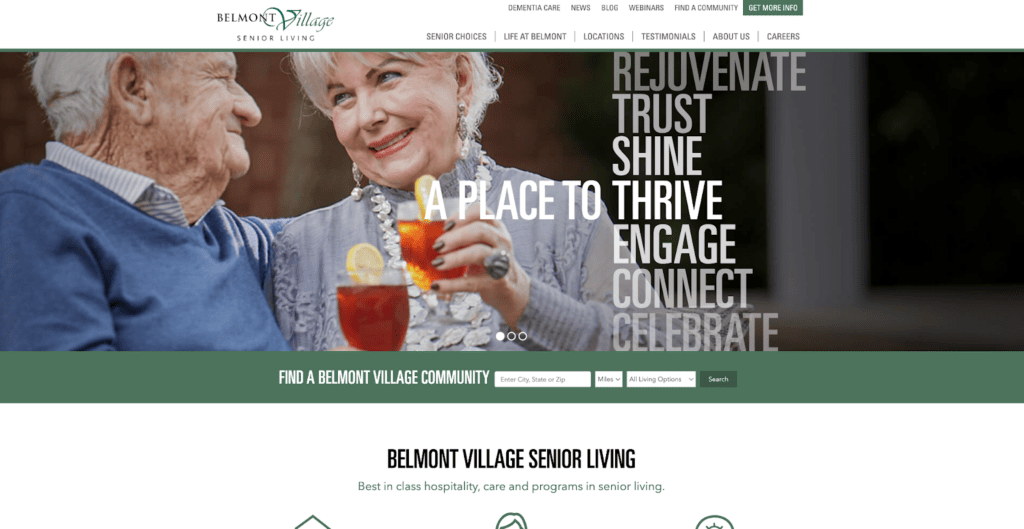
Belmont Village Senior Living’s website is distinct in its engagement strategies and content offerings.
- Navigation includes direct links to blogs and webinars.
- “Get more info” is easily accessible for inquiries.
- Dedicated search bar for community location.
9. Life Care Services
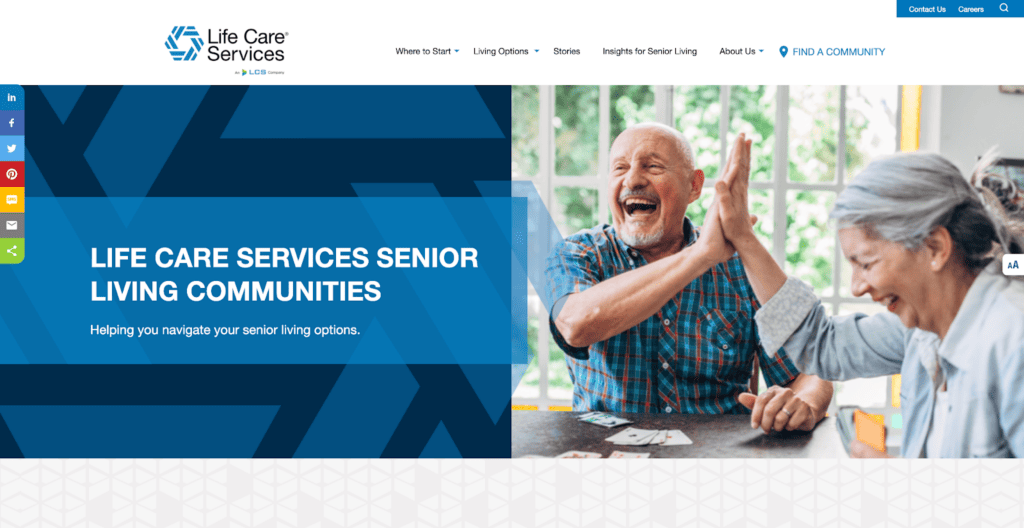
Life Care Services’s website is organized with a user-first approach, guiding visitors step by step.
- Helpful “where to start” section for newcomers.
- Structured guidance through numbered action steps, creating a user “track.”
Why settle for ordinary when you can work with Kaleidico
At Kaleidico, our 20+ years in the industry have positioned us as leaders in creating digital solutions for sectors including senior living communities, mortgage, law, and fintech.
Our comprehensive services encompass:
- Website design and development
- Senior living marketing
- Content marketing
- Email marketing
- Social media marketing
- PPC ads
- Lead buying and generation
If you’re in the senior living sector and seeking a revamped digital presence and a proven senior living marketing strategy, we’re here to help.
Photo by Georg Arthur Pflueger on Unsplash
